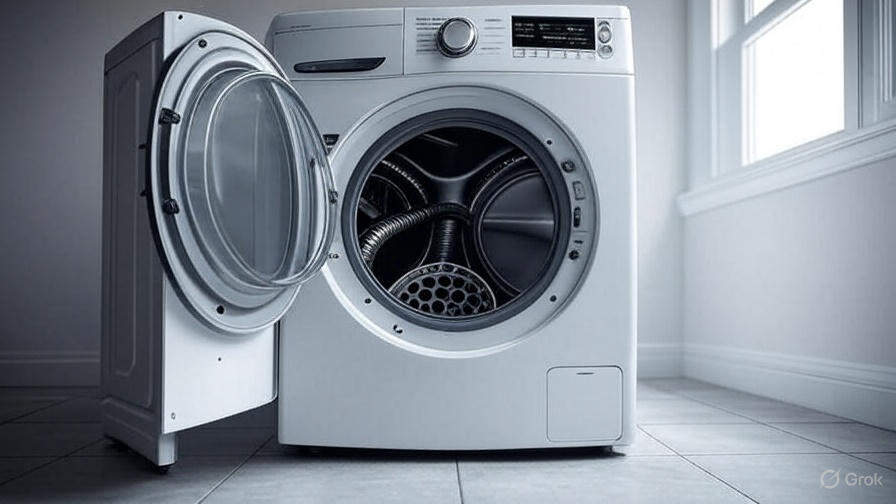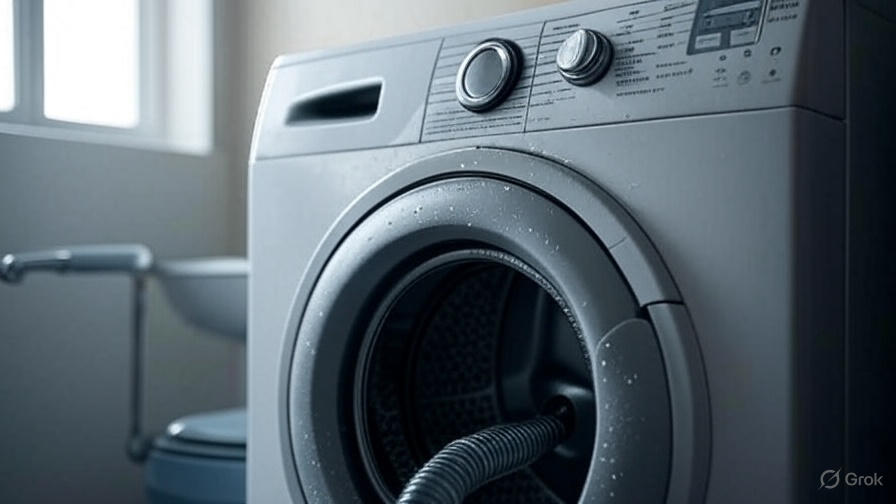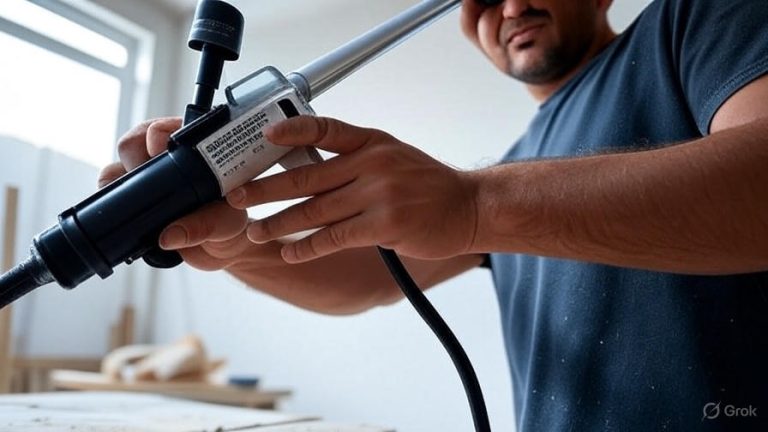How to Drain an LG Washing Machine?
Water trapped in your LG washing machine can create serious problems. You might face foul odors, mold growth, or even damage to your machine’s internal components. This comprehensive guide walks you through every method to properly drain your LG washer, from emergency situations to routine maintenance.
Why Your LG Washing Machine Needs Proper Draining
LG washing machines require complete water removal for several critical reasons. First, standing water becomes a breeding ground for bacteria and mold. These microorganisms produce unpleasant smells that transfer to your clean clothes. Second, leftover water can freeze during cold weather, causing pipes and hoses to crack. Third, stagnant water corrodes metal parts inside your machine, leading to expensive repairs.
Most LG washers automatically drain after each cycle. However, mechanical failures, clogged filters, or kinked hoses can prevent proper drainage. Regular manual draining prevents these issues and extends your machine’s lifespan.
Essential Tools and Safety Preparations
Before starting any drainage procedure, gather these necessary items:
- Large bucket or container (at least 2-3 gallons)
- Old towels and rags
- Flashlight or headlamp
- Pliers (needle-nose preferred)
- Screwdriver set
- Rubber gloves
- Non-slip mat for kneeling
Safety comes first when working with electrical appliances. Always unplug your LG washing machine from the wall outlet before beginning any drainage procedure. Turn off the water supply valves located behind the machine. These simple precautions prevent electrical shock and water damage to your home.
Clear the area around your washing machine. Move any stored items, laundry baskets, or cleaning supplies. You need adequate space to work comfortably and safely access all drainage points.
Method 1: Using the Emergency Drain Hose
Every LG washing machine includes an emergency drain hose designed for situations exactly like this. This small hose sits behind the access panel at the bottom front of your machine.
Start by locating the access panel. Look for a small rectangular or square panel near the bottom of your machine’s front face. Some LG models have a hinged door, while others require you to pop off a plastic cover.
Open the access panel carefully. Inside, you’ll find the emergency drain hose alongside the debris filter. The drain hose typically has a cap or plug to prevent accidental drainage during normal operation.
Place your bucket directly under the drain hose opening. Position it as close as possible to minimize spills. Lay towels around the work area to catch any water that misses the bucket.
Remove the cap from the emergency drain hose slowly. Water will begin flowing immediately, so be prepared. The flow rate depends on how much water remains in your machine. A full load cycle might leave 2-3 gallons of water inside.
Allow the water to drain completely. This process takes 5-10 minutes depending on the water volume. Tilt the hose downward to encourage complete drainage. You’ll know the process is complete when water stops flowing from the hose.
Replace the cap securely once drainage finishes. Push the emergency drain hose back into its storage position and close the access panel. This method works for most drainage situations and requires minimal technical knowledge.
Method 2: Manual Siphoning Technique
Sometimes the emergency drain hose becomes clogged or damaged. Manual siphoning provides an alternative drainage method using basic physics principles.
You’ll need a clear plastic tube about 6 feet long and 1/2 inch in diameter. Garden hoses work well, but clear tubing lets you see water movement. Clean the tube thoroughly before use to avoid contaminating your washing machine.
Open your LG washer’s lid or door. Insert one end of the tube into the drum, pushing it down until it reaches the bottom where water collects. The tube end must stay submerged in the standing water.
Place the other tube end into your bucket, making sure this end sits lower than the water level inside the machine. This height difference creates the siphon effect necessary for drainage.
Start the siphon by sucking gently on the lower tube end until water begins flowing. Immediately place this end into your bucket. Water will continue flowing automatically as long as the siphon remains unbroken.
Monitor the drainage process closely. Empty your bucket as needed to prevent overflow. The siphoning continues until water levels equalize or the tube loses its seal.
This method requires more attention than the emergency drain hose but works effectively when other options fail. Clean and store your siphon tube for future use.
Method 3: Accessing the Drain Pump Filter
LG washing machines feature a drain pump filter that captures lint, coins, and debris. This filter can become clogged, preventing proper drainage. Cleaning the filter often resolves drainage issues while removing trapped water.
Locate the drain pump filter behind the same access panel as the emergency drain hose. The filter typically appears as a round, threaded cap that screws into the pump housing.
Before removing the filter, use the emergency drain hose to remove as much water as possible. This prevents massive spills when you unscrew the filter housing.
Turn the filter counterclockwise slowly. Water will begin leaking out immediately, so keep your bucket and towels ready. As you continue turning, more water flows out along with any debris trapped in the filter.
Remove the filter completely once water stops flowing. Inspect the filter for lint buildup, small objects, or damage. Clean the filter thoroughly under running water, using an old toothbrush to remove stubborn debris.
Check the filter housing for obstructions. Sometimes items like coins or buttons fall past the filter into the pump area. Remove any visible debris carefully with pliers or tweezers.
Reinstall the clean filter by threading it clockwise back into the housing. Tighten it firmly but don’t over-tighten, as this can damage the plastic threads. Replace the access panel and test your machine with a small load.
Addressing Drainage System Clogs
External drainage problems often cause water to back up into your LG washing machine. These clogs occur in the standpipe, drain hose, or household plumbing connections.
Examine the drain hose connection first. This large hose carries wastewater from your machine to the household drain system. Disconnect the hose from the standpipe or wall drain carefully. Water trapped in the hose will spill out, so position your bucket accordingly.
Inspect the drain hose for kinks, cracks, or internal clogs. Run water through the hose to check for proper flow. If water backs up or flows slowly, the hose needs cleaning or replacement.
Clean clogged drain hoses using a plumber’s snake or high-pressure water flush. Feed the snake through the hose slowly, breaking up accumulated lint and debris. Flush thoroughly with hot water afterward.
Check your home’s standpipe for clogs. This vertical pipe receives wastewater from your washing machine. Pour a bucket of water into the standpipe. If water backs up or drains slowly, you have a plumbing clog that requires professional attention.
Sometimes tree roots or household debris clogs the main drain line. These serious blockages require professional plumbing services. Don’t attempt to clear major clogs yourself, as you might damage your home’s plumbing system.

Preventing Future Drainage Problems
Regular maintenance prevents most LG washing machine drainage issues. Simple preventive steps save you time, money, and frustration later.
Clean the drain pump filter monthly. This simple task takes five minutes but prevents major clogs from developing. Mark your calendar or set phone reminders to maintain this schedule consistently.
Use appropriate detergent amounts. Excess soap creates excessive suds that can overwhelm your machine’s drainage system. Follow the manufacturer’s recommendations for your load size and soil level.
Check pockets before washing clothes. Coins, tissues, and small objects commonly cause drainage problems. These items either clog the filter or damage the pump impeller.
Run monthly cleaning cycles using washing machine cleaner or white vinegar. These cycles remove soap residue and mineral deposits that can restrict water flow. Hot water works best for dissolving accumulated buildup.
Inspect hoses and connections quarterly. Look for signs of wear, cracking, or loose fittings. Replace damaged components immediately to prevent sudden failures and water damage.
Keep your laundry room well-ventilated. Proper airflow prevents moisture buildup that can cause mold and mildew problems. Use exhaust fans or dehumidifiers if necessary.
Troubleshooting Common Drainage Issues
Even well-maintained LG washing machines occasionally develop drainage problems. Recognizing symptoms early helps you address issues before they become serious.
Slow drainage often indicates partial clogs in the filter or drain hose. Water takes longer than normal to leave the drum after cycles complete. Clean the filter and inspect the drain hose for restrictions.
Complete drainage failure means water remains in the drum after cycles finish. This serious problem usually involves clogged filters, kinked hoses, or pump malfunctions. Start with the emergency drain method, then investigate the underlying cause.
Gurgling sounds during drainage suggest air entering the drain system. Check drain hose connections and ensure proper venting. Sometimes repositioning the drain hose solves gurgling problems.
Bad odors indicate standing water or organic matter decomposition. Drain the machine completely, clean the filter thoroughly, and run a hot cleaning cycle with bleach or specialized cleaner.
Error codes on your LG machine’s display often relate to drainage problems. Common codes include OE (drainage error) and LE (water level error). Consult your owner’s manual for specific code meanings and recommended actions.
When to Call Professional Service
Some drainage problems require professional technician assistance. Recognizing these situations saves you time and prevents further damage to your washing machine.
Pump motor failures cause complete drainage breakdown. If the emergency drain hose works but normal cycles don’t drain, the pump motor likely needs replacement. This repair requires specialized tools and knowledge.
Control board malfunctions can prevent proper drain cycle timing. If your machine runs but skips the drain portion of cycles, electrical problems might be the cause. Professional diagnosis identifies these complex issues accurately.
Internal hose disconnections require disassembling your washing machine. If water leaks inside the cabinet or drainage works intermittently, internal hoses might have disconnected. Professional service prevents further damage during repairs.
Warranty coverage often includes drainage system repairs. If your LG washing machine is relatively new, professional service might cost nothing. Check your warranty status before attempting complex repairs yourself.
Environmental Considerations and Water Conservation
Proper drainage practices benefit both your washing machine and the environment. Responsible water management reduces waste and utility costs.
Collect drain water for appropriate reuses when possible. Graywater from washing machines can irrigate gardens or flush toilets with proper filtration. Check local regulations before implementing graywater systems.
Use biodegradable detergents that break down naturally in septic systems or wastewater treatment plants. These products reduce environmental impact while maintaining cleaning effectiveness.
Fix drainage problems promptly to prevent water waste. Malfunctioning machines often use excessive water or require multiple wash cycles to clean clothes properly.
Maintaining Your LG Washing Machine for Optimal Performance
Regular drainage maintenance represents just one aspect of comprehensive washing machine care. Following these additional tips ensures reliable, long-term performance from your LG appliance.
Balance your loads evenly to reduce mechanical stress on drainage components. Unbalanced loads cause excessive vibration that can disconnect hoses or damage pump mountings.
Use cold water when possible to reduce energy consumption and extend component life. Hot water causes rubber seals and hoses to deteriorate faster than cold water washing.
Leave the door or lid open after washing to promote air circulation and moisture evaporation. This simple habit prevents mold growth and eliminates musty odors.
Conclusion
Draining your LG washing machine properly protects your investment and ensures reliable performance. Whether you face an emergency situation or perform routine maintenance, these methods provide effective solutions for every drainage challenge.
Remember that prevention beats repair every time. Regular filter cleaning, proper detergent usage, and routine inspections prevent most drainage problems from developing. When issues do arise, start with the simplest solutions before progressing to more complex procedures.
Your LG washing machine represents a significant investment in your home’s functionality. Taking time to understand and maintain its drainage system ensures years of reliable service. Keep this guide handy for reference, and don’t hesitate to seek professional help when situations exceed your comfort level or technical ability.
With proper care and attention, your LG washing machine will continue providing excellent cleaning performance while avoiding the frustration and expense of drainage-related problems.







